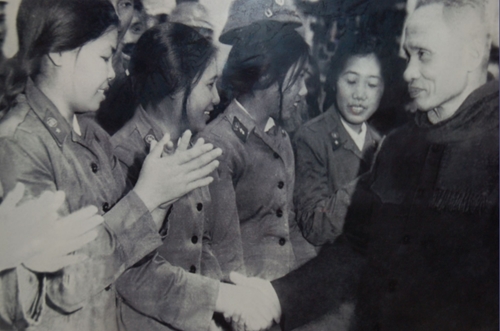After receiving an order from the General Staff of the Vietnam People’s Army (VPA) about ensuring smooth communication as the enemy was about to hit the North, even when they used B-52s to attack Hanoi and Hai Phong, the Signal Corps Command was requested to instruct the Air Defense - Air Force (ADAF) Service to enhance its information system according to new operation plans and apply anti-jamming solutions for shortwave, microwave, and relay radio communication systems.
At the same time, they were also tasked with instructing Signal Regiments 134 and 205 to map out plans, in coordination with functional forces, to be ready to support each other whenever needed.
    |
 |
|
Then Prime Minister Pham Van Dong visits Regiment 205, Signal Corps in December 1972. (A file photo) |
Therefore, the signal force of these units quickly implemented set plans to ensure smooth communication for command, coordination, and reconnaissance, among others. Meanwhile, the landline system had been well-prepared and further finalized at all levels.
Microwave relay stations, in combination with ground-based observatories, ensured smooth communication from the VPA’s General Staff to all mobile anti-aircraft and missile units stationed in the Red River Delta and Northern Military Region 4. Meanwhile, radio relay and electric landline were widely used to connect distant units. In addition, technical troops of the Signal Corps worked closely with signal troops of the ADAF Service to restore the decimeter block of P405 radio transmitters to ensure secret communication and deal with the enemy’s jamming threats.
On December 18, 1972, thanks to reports from radar stations, many B-52s were detected along the Mekong River heading to the North. Through the landline and radio systems, the High Command, the ADAF Service, and the VPA’s General Staff ordered all units to move to their designated positions. When the first group of B-52s approached Hanoi, missile and anti-aircraft artillery troops fought back fiercely. Even though the enemy bombed Vietnamese airports, smooth communication was still ensured between the VPA’s General Staff and the ADAF Service.
Air-defense Division 361 (ADAF Service), tasked with protecting the Hanoi space, used the electric landline system of the High Command and of the post office, while utilizing microwave networks, to command missile and anti-aircraft artillery battalions.
Signal troops of the Hanoi Capital Command and Hai Phong city’s Military Command made full use of the military information system via many forms, such as organizing landline and radio communication in combination with postal landline systems, the city’s radio system to alert the people about B-52s, instruct the militia force to defeat the enemy’s aircraft, and overcome the consequences of their air raids.
Hai Phong city’s Military Command also placed an observatory station on Kien Mountain to send timely signal lights to the air defense headquarters as the enemy attacked the city. Meanwhile, the Hanoi Capital Command used the automated telephone system of the post office to keep in touch with anti-aircraft machine gun battlefields. In Hanoi, people were alerted by buzzers on the roofs of the Opera House, Hang Dau water tower, etc., and loudspeaker systems.
In order to ensure smooth communication in Hanoi, the Signal Corps requested its affiliated units to deploy backup switchboards in many locations in the city; place radio relay and microwave transmitters in the headquarters of the High Command to get in touch with each other and with other stations outside the city.
On December 24, 1972, then Prime Minister Pham Van Dong and Comrade Phung The Tai, Deputy Chief of the VPA’s General Staff, visited and encouraged signal troops at Base Station A40 of Regiment 205, and Base Station A10 of Regiment 134. The prime minister hailed the bravery of the troops and urged them to make further achievements in the fight against the enemy.
During the campaign, troops of Battalion 8, Regiment 134 bravely repaired more than 300 communications poles with 73km of twisted pair cables and promptly restored communications, making contribution to shooting down U.S. B-52 aircraft in the Hanoi sky.
When the High Command sent a series of dispatches to agencies and units in Hanoi, Commanding Officer of Company 6, Battalion 78, Regiment 130 Nghiem Van Sach, together with five female postal soldiers, including Nguyen Thi Kha, Nguyen Thi Hong, Dao Thi Hoai, Pham Thi Nhieu, and Nguyen Thi Nguyet overcame difficulties and dangers to transport the dispatches to on-duty units. They were called “Five missile girls.”
Drivers of Company 6 crossed 3,500km of roads to complete 40 tasks, ensuring timely and safe dispatch and document delivery for the frontline.
On December 26, when enemy aircraft bombarded Thuong Dinh, Cat Linh, Nga Tu Vong, Bach Mai, and Go Dong Da (Hanoi), the communication to the headquarters of the ADAF Service was interrupted in many areas, especially in Nga Tu Vong (Vong Crossroad). Troops of Regiment 205 quickly found the broken part in the dark to ensure smooth communication for the Department of Operations under the VPA’s General Staff and Division 361 to continue their leadership during the campaign.
After 12 days and nights, the people gained a glorious victory. The signal troops will preserve and promote the heroic tradition of their forefathers’ footsteps to ensure smooth communication in the current context, contributing to the cause of national construction and defense.
By Major General Khuc Dang Tuan, Commander of the Signal Corps
Translated by Minh Anh